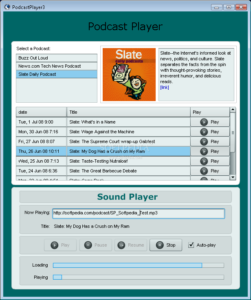Article by- Priyanka Palit
Over the past century communication between organizations and their customers has changed drastically, which started from print, television, radio, phone and fax, and now the fastest medium yet, the Internet. The theory of Computer-Mediated Communication (CMC) has become a part of everyday life. Research has suggested that CMC is not neutral: it can cause many changes in the way people communicate with one another. It can influence communication patterns and social networks (Fulk & Collins-Jarvis, 2001), and leads to social effects. Rice & Gattiker (2001) state that CMC differs from face-to-face communication by limiting the level of synchronicity of interaction, which may cause a reduction of interactivity but CMC can overcome time and space dependencies. The technology of ‘podcasting’ is based on the theory of Time-Shifting, which is the recording of programs to a storage medium, to be viewed or listened to at a time more convenient to the consumer. ‘Podcasting’ can be considered to be a relatively recent addition to internet marketing which became very
Chris Anderson (2006) writes that niche markets are usually ignored by companies with million dollar budgets, since they have the resources to target a mass market. But with podcasts it is possible to target these audiences which are being ignored, giving way to the popular phenomenon of podcast advertising or 
With podcast audiences are expected to jump 450% to 55 million by 2011, marketers are already warming up to the medium’s potential for advertising and research firm eMarketer expects the podcast ad market to grow to $400 million by 2011. The advertising charge in podcasting is currently being led by 3 sectors, mainly: technology, auto and media. New data from Podtrac and TNS suggests that podcasts may be a much more powerful advertising platform than television. According to their study of podcast advertising from February’06 to March’08 unaided awareness for podcast ads was 68%, as compared to the 21% for streaming video and only 10% for television. This is perhaps because people are tired of the continuous ads on television so they routinely time them out, resulting in podcast ads being upto seven times as effective as television ads. Similarly, many people who are listening to broadcast radio are not really paying much attention to the content in the first place and are quick to change the station. But for podcast advertising the user has already subscribed, downloaded and actively chosen to experience the content of the message, so the advertiser already has his attention. However, podcasting does appear also to have had a marginally positive effect on live radio listening, since 15% of the users claimed to have listened to more live radio after they began downloading podcasts. Again, while website viewers suffer many distractions at any given site, podcasts are frequently listened to and focused on while driving, exercising or commuting, so the listener is exclusively consuming one medium at a time. Podcast advertising is thus a lot less intrusive than other mediums of advertising, and also more targeted and relevant.
However, it is important to take a look at the challenges that are faced in the still niche area of podcasting. Leesa Barnes states in Podcasting for Profit: A Proven 7-Step Plan to Help Individuals and Businesses Generate Income through Audio and Video Podcasting (2007) that despite the growth of podcast advertising the number of companies advertising in podcasts to date is quite few. This is perhaps because they are scared of venturing into an unproven area, or are not convinced that their target market is entirely reachable through podcasts. Although iPod sales are unstoppable, regular podcast users are still hard to find. Podcast distributions and viewing mechanisms are proliferating but even the most widely used podcasts have fewer than 50,000 downloaders. Among the challenges are finding ways of measuring, listening and buying ads on a medium that has so far been made up of small fragmented audiences. It has also been argued that podcasting is one way and there is very little conversation. It is true that podcasts are not as interactive as something like live radio but podcasters do read and play audio comments from previous shows even if is not in real-time. However, Tracy Sheridan’s brainchild Waxxi is a new kind of podcast where listeners can call in toll-free and participate in real-time conversation. As with many new learning technologies there are specific issues faced by podcasting which are mostly IT related, or related to time and cost. The IT related issues are the hardest to tackle, with problems such as blocked access to mp3 file downloads, lack of access to internet hosting sites for audio files, inability to get RSS feeds working or limited access to editing software. The listeners need to install a software or ‘podcatcher’ to start receiving podcasts and part of the solution is that podcasting uses RSS 2.0 feed standard, so many of the RSS readers have upgraded to support podcasts. Another long standing problem for podcast advertising is the business model, and trying to find advertisers to sponsor a podcast. Now new ad-insertion companies like Fruitcast, Podbridge and Podtrac are helping podcasters gain revenue by podcasting ads, with the companies keeping a certain percentage of the profit generated. There is also the difficulty of tracking podcasts beyond the number of downloads which lies in the portability of the files, for which podcast advertisers are turning to techniques such as custom 800 numbers or offer codes.

References
Barnes, L (2007). Podcasting for Profit: A Proven 7-Step Plan to Help Individuals and Businesses Generate Income Through Audio and Video Podcasting. Maximum Press, Gulf Breeze, FL, USA.
Demopoulos, T (2006). What No One Ever Tells You about Blogging and Podcasting: Real-Life Advice from 101 People Who Successfully Leverage the Power of the Blogosphere. Dearborn Trade, A Kaplan Professional Company, Chicago, IL, USA
Dowell, B (2008). Podcasts help lift live radio audiences. Available at www.guardian.co.uk. Accessed 12 Oct 2008.
Duncan, A (nd). Selling Advertising for Your Podcast. Available at
http://advertising.about.com/od/smallbusinesscampaigns/a/podcastweb.htm. Accessed 12 Oct 2008.
Galant, G (nd). The CEO of RadioTail outlines five tips for successful podcast advertising. Available at http://www.imediaconnection.com/content/9614.asp. Accessed 12 Oct 2008.
Kiss, J (2008). Vogue launches podcasts for London Fashion Week. Available at
guardian.co.uk. Accessed 12 Oct 2008.
Lewin, J (2008). Advertisers Begin To Target Podcasts. Available at http://www.podcastingnews.com/2008/06/21/advertisers-begin-to-target-podcasts/. Accessed 12 Oct 2008.
Marketing with Podcasts: Advantages, Applications, and Challenges (nd). Available at http://podcastingscout.com/marketing-with-podcasts. Accessed 12 Oct 2008.
Mathieson, R (2005). Branding Unbound: The Future of Advertising, Sales, and the Brand Experience in the Wireless Age. AMACOM, Saranac Lake, NY, USA
Mello, J (2007). Podcast Advertising: A $400M Business by 2011? Available at
http://www.macnewsworld.com/story/55990.html. Accessed 12 Oct 2008.
Newcomb, K (2005). Podcasting Ads Face Challenges. Available at
http://www.clickz.com/showPage.html?page=3517416. Accessed 12 Oct 2008.
Plummer, J (nd). Time Shifting Time – Podvocation – What it is and why you should care. Available at http://www.problogger.net/archives/2005/11/04/podcast-advertising-fruitcast/. Accessed 12 Oct 2008.
Rumford, R (nd). Business Podcast Marketing Case Study Proves Results. Available at Accessed 12 Oct 2008.
Sweeney, S (2006). Internet Businesses You Can Start from Home : How to Choose and Build Your Own Successful E-Business (2nd Edition). Maximum Press, Gulf Breeze, FL, USA
Sweeney, S (2007). Marketing on the Internet: Third Generation Internet Marketing Strategies for Online Success (7th Edition). Maximum Press, Gulf Breeze, FL, USA


PODCAST MARKETING – A new paradigm for the internet era
sac longchamp
ddqj